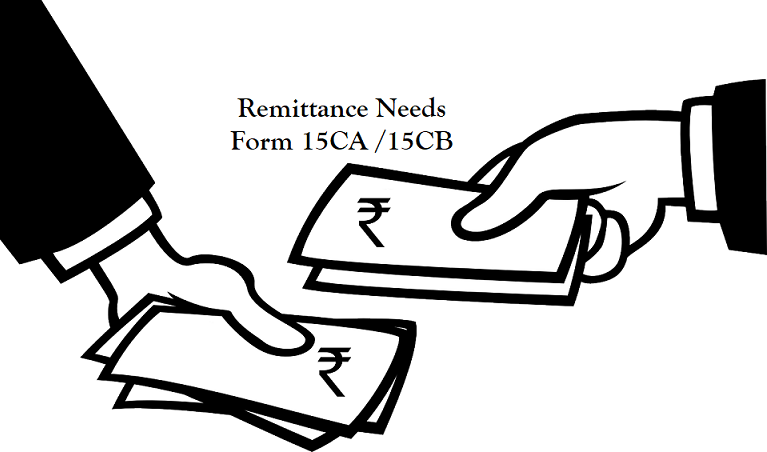Remittances have become very common between Non-Resident and residents. To track and collect tax on early stages because recovering tax at a later stage for an NRI will be difficult – Form 15CA and Form 15CB are widely used. Lets us check the meaning, requirement, difference & procedure to obtain Form 15CA and 15CB.
Many NRIs/Residents are confused when to use which of the Form 15CA and CB? Here are the details, applicability, procedure & difference between form 15CA and 15CB.
So if you are making a remittance or payment to an NRI, An NRI transferring money from his NRO to NRE a/c, or a Foreign Company, you need to file form 15CA and in some cases (explained below) form 15CB also.
What is form 15CA and 15CB?
It is a tool for the collection of information for the payments which are chargeable for tax in the hands of NRI. So it a Self Declaration of remitter against his tax liability that arises when the payment is to be made.
By form 15CA Income Tax Department can easily track the foreign remittances and their nature to determine the income tax liability.
Now the banks and authorized money transfer institution are keeping careful watch for possible danger and difficulties in ensuring that such forms are received by them before remittances are affected.
According to revised rule 37BB of income tax act 1961, it is their duty to furnish this form 15CA received from remitter to the authority (RBI).
Is Form 15CA compulsory?
Yes, the form 15CA is compulsory to be filled by an NRI for all payments more than Rs 500000 in a financial year.
It’s is also clear that Form 15CA is not required if the remittance amount is not chargeable for tax.
In case you are transferring from NRO A/C to NRE A/C, RBI allows a limit of $1 Billion per financial year. But banks may insist on Form 15CA.
After the amendment in income tax rules in 2013 & 2016, if the payment is made for the purpose mentioned in this specified list, the Form 15CA or CB is not required as per Rule 37BB.

Update: The list of 28 has been revised to 33. Here is the copy of Press Release by CBDT.
What is Form 15CB?
Form 15CB is decalaration by a CA that, all taxes have been paid on the amount under transfer.
This form is basically used for the avoidance of double taxation (DTAA) and also for determining the tax deduction under the income tax rules. The form 15CB is examined by the charted accountant and certified by him.
The form includes details of remittee and remitter and nature of remittance like salary, royalty, commission as per the agreement of both sides bank details of remitter in case of remitter lies in DTAA (double taxation avoidance agreement).
Procedure for Filling Form 15CA and Form 15CB
Form 15CA is filled online on official website of the income tax.
The form is required to be furnished with all details of the remittee & remitter.
The PAN or TAN No. should be valid.
Form 15CA has 4 parts. The picture below will help you to identify which part needs to be filled under what circumstance. The 4 parts are:
PART A: – When the remittance or the aggregate of such remittance does not exceed 5 lakh rupees during the F.Y. (whether taxable or not).
PART B: – Where an order /certificate u/s 195(2)/ 195(3)/197 of Income Tax Act has been obtained from the A.O. (Whether Nil rate or Lower rate Certificate).
PART C: – When the remittance or the aggregate exceeds 5 lakh rupees during the FY.
PART D: – Where the remittance is not chargeable to tax under Domestic law.
This flowchart explains which part is to be filled when?

Form 15CB is a tax certificate where the CA examines the remittance.
He certifies that it is under Section 5 and 9 of the Income Tax Act. Also if Double Tax Avoidance Agreements (DTAA) provisions apply.
This is also filled online, using the “add CA” option in the income tax website login. Once the CA is added, you or the CA can file the form 15CB.
In form 15CB, a CA certifies details of the payment, rate of TDS and TDS deduction as per Section 195 of the Income Tax Act, if any DTAA is applicable, with other details of nature and purpose of the remittance.
It is advisable to obtain 15CB even in cases where 15CA is not mandated. This is to avoid future problems related to tax assessment.
Below image shows the procedure & need when Form 15CA and 15CB are required.

Hope the article clarifies the need and procedure to file form 15CA and Form 15CB. Please share with your family members or friends who are NRI or deal with NRIs.
Disclosures
The writer is not a CA or tax consultant. The article is written with intention of providing information only. It is suggested that you consult a practicing expert before taking a decision on basis of information provided here.










